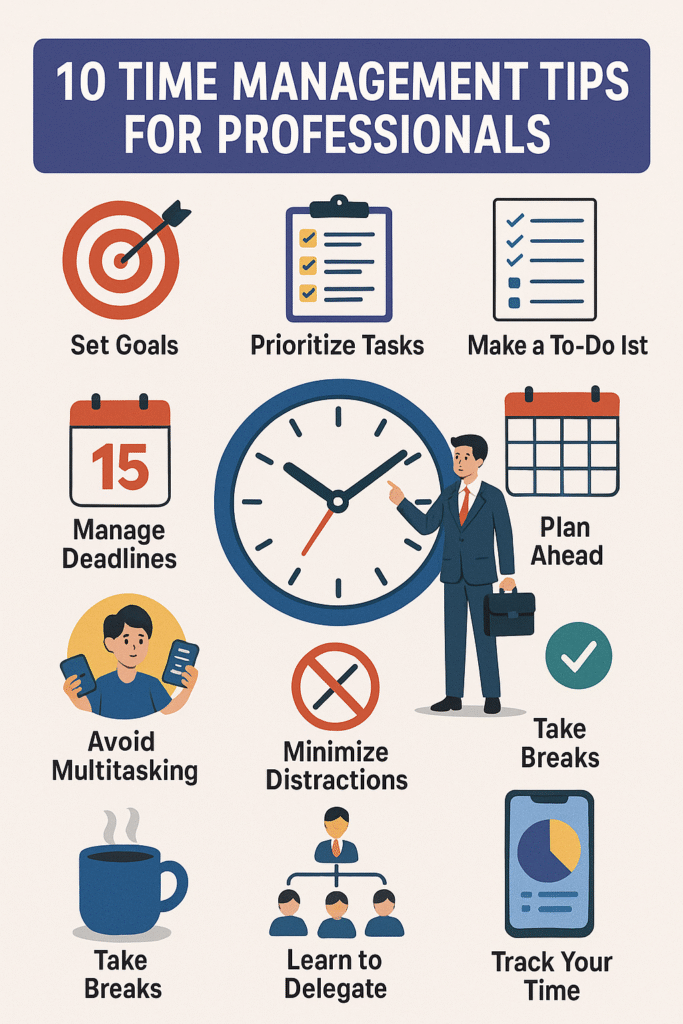10 Time Management Tips for Professionals

In today’s fast-paced professional world, mastering your time isn’t optional — it’s essential. Whether you’re juggling multiple projects, leading teams, or managing remote work, efficient time management can make or break your productivity. Here are **10 actionable tips** to help professionals get more done with less stress.
1. Track Your Time to Find Reality
Before optimizing your schedule, you must know how you currently spend your time. Use a time-log (for example, in 15- or 30-minute blocks) for one week. Note everything: tasks, breaks, interruptions.
This helps you identify time sinks and patterns (e.g. “I lose 1 hour daily in unplanned meetings”) so you can make informed adjustments.
2. Prioritize Using the Eisenhower Matrix
Not every task is equally important. The **Eisenhower Matrix** helps you categorize tasks into:
* **Urgent & Important**: Do immediately
* **Important but Not Urgent**: Schedule them
* **Urgent but Not Important**: Delegate
* **Neither Urgent nor Important**: Eliminate
Focusing on “important but not urgent” work allows you to proactively manage your goals rather than constantly firefighting.
3. Apply Time Blocking
Divide your day into blocks (time slots) reserved for specific types of work (e.g. “creative work,” “administrative tasks,” “email follow-ups”).
By committing to single tasks during each block, you minimize multitasking and context switching.
Tips:
* Use your highest-energy hours for demanding work
* Buffer short breaks between blocks
* Be realistic — don’t overfill your day
4. Use the Pomodoro Technique
This method divides work into 25-minute focus intervals (“pomodoros”) followed by short breaks (5 minutes). After four intervals, take a longer break (15–30 minutes).
Benefits:
* Maintains focus
* Limits burnout
* Makes large tasks feel more manageable
You can adapt intervals (e.g. 50/10) depending on your style.
5. “Eat the Frog” Early
“Eat the Frog” refers to tackling your hardest, most important task first thing in the day. Once done, your mental load lightens and the rest of the day feels easier by comparison.
This helps you avoid procrastination and builds momentum.
6. Leverage the “Two-Minute Rule”
If a task takes less than two minutes to do (e.g. sending a quick email, filing a document), do it immediately rather than postponing it. The overhead to log or schedule it often costs more than doing it.
This rule keeps small tasks from piling up and overwhelming you.
7. Delegate What You Can
As a professional, some tasks don’t require *your* direct involvement. Identify tasks others can handle (or automate) and delegate clearly. Define scope, deadlines, and deliverables.
This frees you to focus on high-value work that requires your expertise.
8. Batch Similar Tasks
Group related tasks and handle them together. For instance, make all phone calls in one block, do all data entry together, or check social media / emails only twice daily.
Batching reduces the cost of task switching and increases efficiency.
9. Limit Distractions and Set Boundaries
Distractions (notifications, chatty co-workers, open browser tabs) are major time stealers. Some methods to curb them:
* Silence or schedule notifications
* Use “Do Not Disturb” during deep work
* Close irrelevant browser tabs
* Use website blockers for social media
* Inform colleagues of your focus times
You can also create visual cues (e.g. “deep work in progress” sign) to help others respect your time.
10. Review & Adapt Weekly
At the end of each week, reflect:
* What worked?
* What didn’t?
* Which tasks took more time than expected?
* What needs adjustment for next week?
Use that insight to continuously refine your schedule and methods. Time management is not static — it evolves with your goals and workload.
Bonus Tips for Sustained Success
* **Set SMART goals** (Specific, Measurable, Achievable, Relevant, Time-bound) to ground your daily tasks in clear direction.
* **Protect your energy** (adequate sleep, breaks, exercise) — good time management fails when you’re exhausted.
* Maintain a **“waiting for” list** (tasks pending on others) to prevent oversight.
* Use **digital or analog tools** you actually like and will stick to (planner, calendar app, task manager).
Conclusion
Mastering time management is a continuous journey. These 10 tips provide a robust foundation you can mix, match, and refine according to your working style and responsibilities.
If you implement just a few consistently — tracking, prioritizing, time blocking, and weekly reviews — you’ll likely see improved productivity, less overwhelm, and more control over your day.